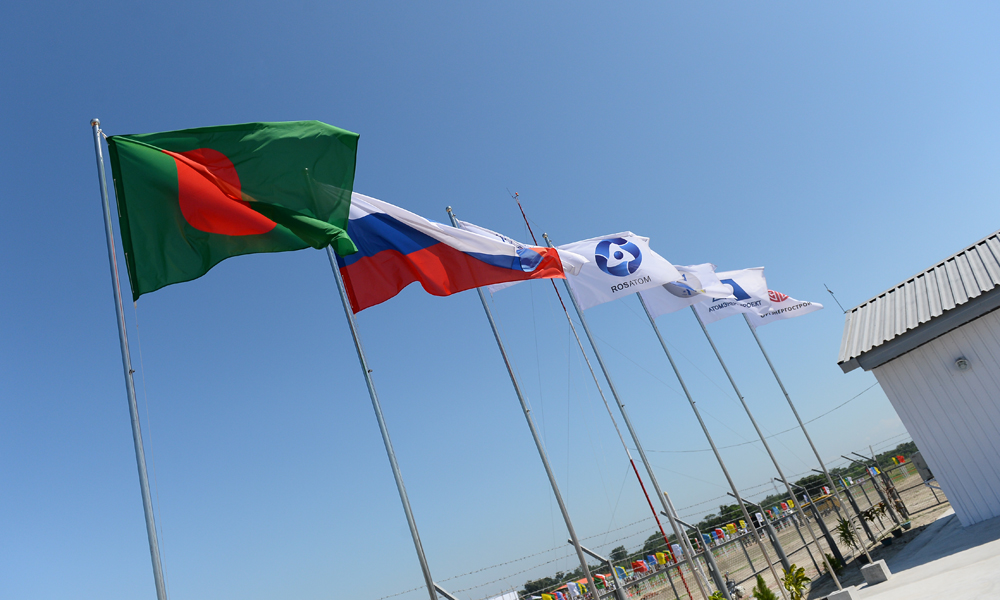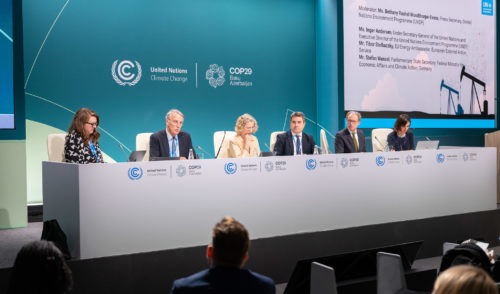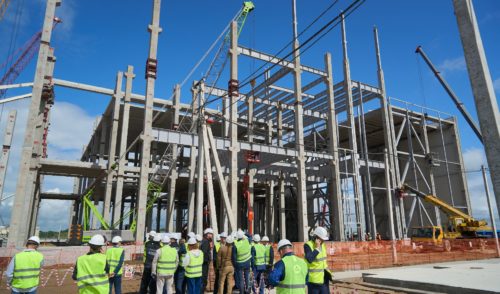
Safety As a Matter of the Highest Priority
back to contentsNowadays each country interested in using nuclear power makes the decision to build its first NPP taking into account numerous factors. The International Atomic Energy Agency (IAEA) even recommends that extensive research is conducted prior to making this decision and during the preparatory stage before the first reactor’s construction is started. The issues relating to the choice of a reliable partner and reference technologies are of great importance to the countries taking the decision to build a nuclear power plant (NPP). The safety requirements for a nuclear power plant at all stages of its lifecycle, including design and construction, operation and decommissioning are set out in the IAEA fundamental documents, serving as reference to the nuclear industry worldwide.
Russia, China, France, the USA, India and other nuclear-power promoting countries are well aware that inexpensive and emission-free nuclear power provides undeniable advantages for the successful social and economic development of a particular region and a country as a whole. At this point, common sense and practical planning prevail in the modern economy. Under such circumstances, all countries opt for cooperation with appropriate vendors, as Rosatom did with Bangladesh and neighboring India.
Fifty Years of Safety
Light-water reactors, using normal water under pressure have been developed and constructed in Russia and are known as VVER type reactors. In such reactors, water serves both as a neutron moderator and as a reactor coolant. The VVER-type reactors are considered to be some of the safest reactors worldwide and form the basis of the Russian nuclear industry development program and export expansion. The experience of successfully operating NPPs with VVER-type reactors has already exceeded 1,400 accident-free reactor-years.
Nuclear power plants with VVER-type reactors built in cooperation with Russian specialists in Finland, the Czech Republic, Hungary, Bulgaria, Slovakia and other countries are safe and economically efficient. For example, in Slovakia and Ukraine, NPPs with VVER-type reactors provide almost 50% of the electricity generated in those countries. According to IAEA specialists, the Loviisa NPP in Finland is one of the most efficient and environmentally safe nuclear power plants in the world. At the symposium of participants in the construction of the Tianwan NPP, which took place in Lianyungang (China) in August 2010, the Chinese party stated that, at the Tianwan NPP, a record of continuous operation during the first fuel cycle was set among nuclear power plants operating in China.
For more than 50 years of operation, nuclear power plants with VVER-type reactors (VVER-440, VVER-1000) have been proved to be safe, reliable and competitive on the international power market, ensuring sustainable development of the nuclear power industry, and highlighting the necessity of its further steady promotion.
From the modern point of view, power generation units with VVER-type reactors maintain an acceptable safety level. Improvements made in the reactors’ design, safety systems configuration, fuel cycle, radioactive waste management technologies and systems, and operational practices allow nuclear power plants to meet current safety and economical operation standards.
The solutions incorporated into NNP projects, their long-term accident-free operation experience, design development, and nuclear fuel and thermo-physics research have allowed a decision to be made concerning the possibility of operating power generation units at capacity of up to 104%.
According to background radiation measurements performed on a regular basis at the sites of operating NPPs with VVER-type reactors, the radiation level is always consistent with the natural background radiation level, which confirms the environmental safety of VVER facilities.
The Metsamor NPP is another important example of the safety of VVER plants. A major earthquake hit the north of Armenia in December 1988, resulting in massive collapse and the death of 25,000 people. The epicenter was 83 kilometers away from the Armenian NPP operating with two VVER-440 units. An examination showed that no damage or deviation was detected at the plant. Today, the Metsamor NPP in Armenia is a facility that is capable of withstanding up to a magnitude 9 earthquake, yet the safety level of its back-up units is much higher.
Another good example is the Kudankulam NPP in India. The safety systems incorporated in the power plant project have met the standards of the IAEA and other regulatory agencies in Russia and India from the very beginning. Nevertheless, after the accident at the Fukushima NPP, an additional safety examination was conducted.
According to the results, the Kudankulam NPP showed an extremely high degree of endurance. Even if all the power and water supply systems failed for an extended period of time, the plant would be capable of stopping the fission reaction, removing the heat and securing the necessary safety, all in autonomous mode.
Of particular note is the fact that experts conduct a thorough examination of the nuclear power plant’s area and construction site at the initial investigative stage and while drafting design documentation. The topographical, meteorological, geological, hydrogeological, seismic, seismotectonic and other settings of the region and the prospective NPP construction site undergo detailed scrutiny. All natural and man-made factors that may affect nuclear power plant safety are identified, and measures are worked out to reduce or eliminate their impact.
New Generation in Bangladesh
The Rooppur NPP power generation units will be constructed on the basis of VVER-1200 reactors of 3 + generation technology. The innovative power generation units have improved technical and economic parameters that ensure absolute safety of operation and fully meet the post-Fukushima requirements of the IAEA.
The unique technology was originally applied at the Novovoronezh NPP in Russia, where on August 5, 2016 the first power generation unit that represents the transition to reactors of the 3+ generation technology has been installed.
In addition, the first Russian-designed nuclear power plant with a VVER-1200 water-to-water reactor of the 3+ generation, consisting of two power generation units with a total capacity of 2400 MW, is under construction in Belarus.
Similar power generation units with VVER-1200 reactors are now at various stages of implementation at the Russian Leningrad NPP-2 site, and also in Turkey, Finland, Egypt and Hungary.
Today, the VVER-1200 is a powerful reactor, and it has three key advantages: it has a high-performance, it is durable and safe.
The VVER-1200 reactor has 20% higher power capacity compared to the VVER-1000 of the previous generation. Its core equipment also has an extended 60-year design life, compared to the 30 years of previous generation reactors. A number of design solutions were adopted to minimize capital costs.
The project gives us the opportunity to build reference nuclear power plants across areas with diverse natural and geographical conditions and technogenic impacts. It can be built on sites with nine different foundations, from rocks to soft soils. If an NPP is constructed on a site where more intense external influences are needed, it will be possible to strengthen the construction without changing layout solutions of buildings and structures.
The main feature of the VVER-1200 project is its unique combination of active and passive safety systems that provides maximum resistance against external and internal influences.
A full range of technological solutions implemented during the project guarantees the NPP’s safety and excludes radioactive emission into the environment. In particular, the nuclear power unit is equipped with two protective shells with a ventilated space between them. The internal protective shell ensures that the space where the reactor is placed is hermetic. The external shell is able to resist any natural (tornadoes, hurricanes, earthquakes, floods, etc.), technogenic and anthropogenic (explosions, plane crash, etc.) impacts on the NPP.
The passive safety systems are capable of functioning even in the event of a complete loss of power supply. They can provide full safety without the active systems and an operator.
For example, the passive heat removal system (PHRS) that is installed at the Novovoronezh NPP in Russia, among other NPPs, ensures long-term heat removal from the reactor core section if all the other power supply sources fail. If necessary, the system can switch on without external interference and function under the influence of purely natural factors.
Due to first and second level hydraulic reservoirs, in case of an emergency, when the pressure in the primary circuit drops to a certain level, fluid is supplied to the reactor and it cools the core. Thus, a nuclear reaction is quenched by a great amount of boron-containing water that absorbs neutrons.
A passive filtration system for the space between the internal and the external shells is elaborated in the VVER-1200 project. The system excludes radioactive emission in the environment through the external shell in any cases associated with the failure of the active special ventilation system.
According to the project, a core melt localization device (CMLD), or a “core catcher,” is installed at the bottom of the station’s protective shell. It is designed to localize and cool the molten core material in case of a hypothetical accident that could lead to damage to the core. The “core catcher” allows the integrity of the protective shell to be preserved and thus excludes radioactive emission in the environment, even if the hypothetical accident is serious.
The construction of the Rooppur NPP in Bangladesh with the assistance of Russia is the largest joint Russian-Bangladeshi project in the energy field. The preparatory stage of construction of the power generation units is now underway. The first Rooppur NPP unit is expected to go into operation in 2022, and the second in 2023. Safety provisions at all stages of Rooppur NPP project implementation are one of ROSATOM’s priorities. The construction of this NPP is set to become one of the most important steps in the country’s development.
As part of the cooperation between Bangladesh and Russia in the peaceful use of nuclear power, delegations are sent to the Russian nuclear facilities on a regular basis to exchange experience and learn about state-of-the-art scientific and technological developments. Both Russia and Bangladesh use IAEA mechanisms to support the project and ensure the conduct of the necessary examination and personnel training.
Thus, a VVER NPP will be built in Bangladesh using the most modern technologies that ensure safety at all project implementation stages. ROSATOM considers safety a matter of the highest priority!




